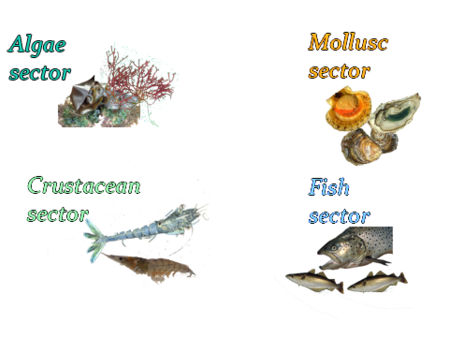Algae used as food
Aquaculture fact sheet - 01 November 2004
http://en.aquaculture.ifremer.fr/Info.-Card
History
Since ancient times, coastal populations have used marine plants as food complement, as soil fertilizer, as fuel, as fodder for animals. Traces of algae found in ashes of prehistoric fire places allow us to think that algae were used in very early times as food stuff.
Unlike countries in South East Asia where alga are widely consumed, Europe is a very small consumer. Some countries – such as Ireland – always have and are still using algae, and markets often sell fresh “dulse” ( Palmaria palmata), together with more conventional salads. In Norway, “black butter” is prepared using boiled algae, whereas in Normandy (France), “blanc manger” is a custard prepared using dried Chondrus crispus added to milk that is boiled and which congeals as it cools down.
Authorization
In France, in December 1988, eleven species were approved for human consumption.
List of algae approved by the ‘’Conseil Supérieur d’Hygiène Publique’’ (High Board of Public Health) in December 1988.Species | Common or commercial name |
|---|---|
Porphyra sp. | Nori - laver |
Undaria pinnatifida | Wakame |
Himanthalia elongata | Sea bean |
Ulva sp. | Sea salad |
Palmaria palmata | Dulse |
Chondrus crispus | Irish moos or Pioca or lichen carragheen |
Gracilaria verrucosa | Ogonori |
Enteromorpha sp. | Aonori |
Ascophylum nodosum | Black Goëmon |
Fucus vesiculosus et spiralis | Black Goëmon |
Spirulina sp. | Spirulin |
The brown alga Laminaria digitata – initially approved – has been temporarily prohibited due to its excessive iodine content.
Nutritional value
The algae used as food products are mainly perceived as health food owing to their high vitamin content, low lipid content, and high trace element content. Just a few tens of grams of alga every day are sufficient to cover the vitamin and mineral salt intakes of a human.
As to the nutritional value, many species of algae contain elements which are difficult to digest:
- Saccharides, present in high quantities in algae, are often unaffected by the action of the alpha-amylase enzyme produced by the pancreas.
- Proteins, usually present in low contents except in a few species such as Laver, are indigestible due to the presence of numerous polysaccharide molecules with which they are associated.
It is however possible to improve the nutritional value of these foods by means of glucanase or cellulase-based enzymatic pretreatment. Conversely, certain species –such as the Porphyra tenera (Laver) - have a very high nutritional value, with a digestibility in excess of 70 % with more than 30 % of proteins.
Japanese taste
In Japan, 90 % of the algae are used for human consumption.
The Wakame ( Undaria pinnatifida) is very crunchy and is used for salads, pickled or vinegary dishes, or as garniture in sashimis (raw fish preparation). |
Undaria, highly appreciated, is cooked under hot ashes. |
Laver leaves are used for the preparation of Sushi, and they are also consumed grilled or diced.
| All the species lend themselves to soups. The Kombu ( Laminaria japonica) and the Hijiki ( Hizikia fusiform) are prepared boiled or sautéed. |
In Asia, in terms of customs and social values, these products are as valuable as wine in Europe. Just as we boast oenology, there is in Asia, mainly in Japan, a science of algae which assesses the quality of the commercialized products.
We are not surprised to see a bottle of vintage Château Petrus being sold for 150 to 300 €, and in Japan hundred grams of dried Laver leaves can reach 300 to 360 €.
Westernization
The adaptation to Western taste has led to the commercialization of a certain number of preparations, amongst which the alga court-bouillon, alga mustard, vinegar alga purée, alga-based salads. Health-food shops, delicatessens, some caterers and fish shops now sell alga-based drinks, light cold meat, croquettes and fish soups. The sea bean ( Himanthalia elongata) together with the Palmaria palmata, is one of the most promising species which is widely used in Brittany cuisine.

